
Turvey Abbey is located in the village of Turvey in the English county of Bedfordshire. It is dated 1605 on the north facade and 1608 on the south facade. The building is stone, with a tile roof. A dovecote, which no longer belongs to the Abbey, is a Grade II listed building.
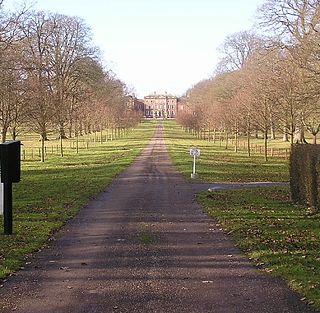
Hill Court Manor is a country house built in 1700 at Hom Green, Walford near Ross-on-Wye in Herefordshire. The house is a Grade I listed building. It is currently owned and occupied by the Rehau Group.

Close House is a country estate near Heddon-on-the-Wall, Northumberland. The estate contains a Grade II* listed former mansion house, which is currently a private residence, and Close House Golf Club.
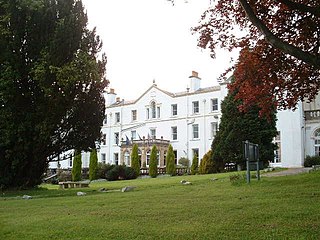
Court Colman Manor is a historic Tudor mansion in Pen-y-fai, Bridgend, South Wales. The property belonged to Margam Abbey until the Dissolution, after which it passed through several hands. It was built in 1766 by Hopkin Rees (1729–1780) and enlarged and modified in 1907 by Robert William Llewellyn (1848–1910).

Hale Park is a country house and landscape park in the village of Hale, Hampshire. It was designed and built by Thomas Archer around 1715.

Daniel Higford Davall Burr JP DL was a British Member of Parliament and Justice of the Peace.
Horsman's Place was an estate situated in Dartford, Kent, England. For several centuries the main residence was an early Elizabethan mansion. Thomas Horsman, the estate's namesake, inherited the mansion by marriage in 1420.
Hartsfield Manor is an early Victorian house of historical significance located in Betchworth, Surrey, England. It was built in the 1860s as a private residence and served this purpose for several notable people until World War II. After this it became a hotel and then a training centre. It is now a venue for special events such as conferences and weddings.

Sandywell Park is an Jacobean Georgian manor house, five miles east of Cheltenham in Gloucestershire, England. Built in 1704 by Henry Brett, it was extended a few times over the 18th century. In the mid-eighteenth century the Sandywell Park estate acquired the Whittington Court building. Sandywell Park is today a Grade II listed building.

The Grove is a heritage listed building of historical significance located south of Narberth, Pembrokeshire. It was built by Daniel Poyer in about 1680 shortly after he inherited the property from his father. The house remained in the Poyer family for the next two centuries. Today the Grove is a hotel and restaurant. It caters for special events particularly weddings.
The Grange was a country house and estate at the village of Chalfont St Peter in Buckinghamshire, England, in the United Kingdom.

The Mynde is a Grade I listed country house in the village of Much Dewchurch, Herefordshire, England which dates from the 15th century.

Penyard House, Weston under Penyard near Ross-on-Wye is a building of historical significance. It appears to have been built in about 1821 by a wealthy landowner John Partridge. It was the home of many notable residents for the next century until it was converted to a hotel in the 1930s. Today it is a hotel which provides restaurant services and caters for special events particularly weddings.

Northaw Place is a Grade II* listed former mansion house, later a school and children's home, in Northaw and Cuffley, Hertfordshire, England. Northaw Place was built circa 1690 by Sir George Hutchins, King's Serjeant and one of the Commissioners of the Great Seal. Cussans describes the Northaw estate as having once formed part of the manorial estate but it became detached from it in circa 1690 when Sir William Leman, second Baronet, and Lord of the Manor of Northaw, gave it to his daughter Sarah, on her marriage to Sir George Hutchins. It remained in private hands until the late 19th century, when it was converted into a school. It reverted to private ownership again in 1927, only to be purchased by Middlesex County Council after World War II and converted into a children's home. With the 1974 re-organisation of UK local government it passed to the London Borough of Haringey who used it as a Children's Assessment Centre until late 1979. In 1980 a planning application was made to convert Northaw Place to 10 dwellings. Permission was granted but the scheme was not implemented due to outstanding conditions of consent. A subsequent application to convert Northaw Place to offices was refused in 1982 (S6/0120/82). Another application was submitted in 1985 to convert Northaw Place to six dwellings (S6/0368/LB), and permission was granted. In 1986 Northaw Place was bought by Hitchins (Hatfield) Ltd, and a new planning application was submitted. This contained minor amendments from the previous application. As part of the conversion work the main house was divided from the stables / coach house to the west by the demolition of a link building. It has since been converted to residential accommodation.
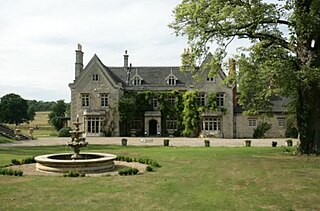
Pipewell Hall in Northamptonshire, England, is a building of historical significance and is Grade II listed on the English Heritage Register. It was built near the ruins of a Cistercian abbey in 1675. At this time it was owned by the Barons of Powis. The house was constructed from the stones of the abbey. The Hall was the home of many notable people over the next three centuries and is now a wedding venue.
Treville is a rural area and former royal forest in the English county of Herefordshire. It is near Wormbridge and other small settlements.
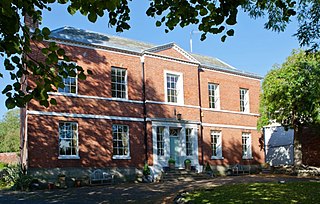
Breedon Hall, Breedon on the Hill in north-west Leicestershire, is a house of historical significance and is listed on the English Heritage Register. In 1620 it was a small timber-framed cottage. Soon after it was bought by the Curzon family and was successively enlarged until 1777 when it was given a new Georgian front. It was the ancestral home of the Curzons for over three centuries and then bought by the Shields family. Today it is owned by the Meynell family and provides bed-and-breakfast accommodation.

Easby Hall near Richmond in North Yorkshire, England is a building of historical significance and is listed on the English Heritage Register. Built in 1729 by the Reverend William Smith, Easby Hall became the home of many notable people for the next two and a half centuries. It now provides bed and breakfast accommodation and is a venue for special events.
Rocklands House near Goodrich, Herefordshire, England, is a building of historical significance and is listed on the English Heritage Register. It was built in the 1700s, and substantial additions were made in 1800. It was the home of many notable people over the next two centuries.
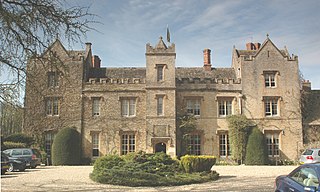
The Manor Country House Hotel in Weston-on-the-Green is a building of historical significance and is Grade II* listed on the English Heritage Register. It was built in the late 15th century and was the home of many notable people over the next five centuries. Today it is a hotel which provides accommodation, restaurant facilities and caters for special events.

















